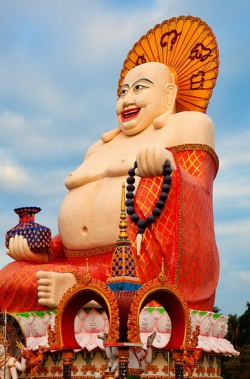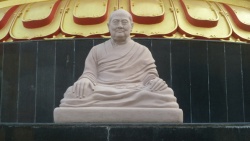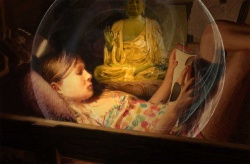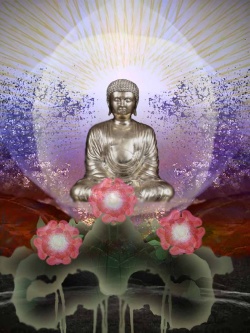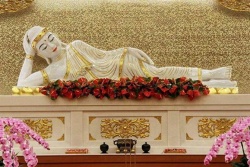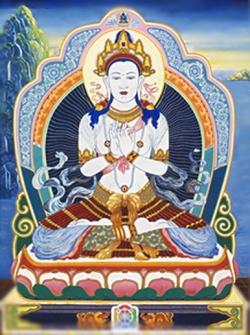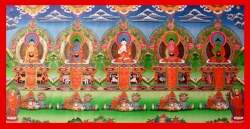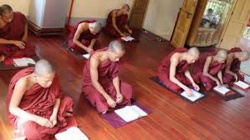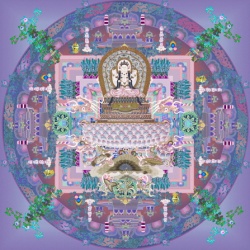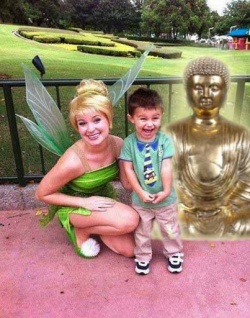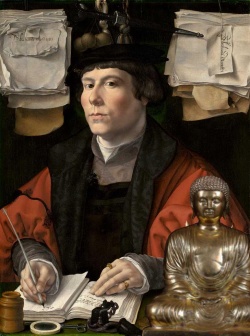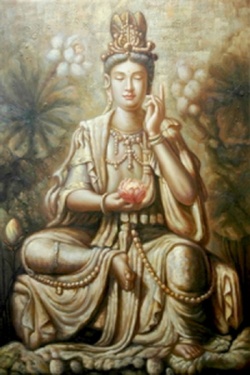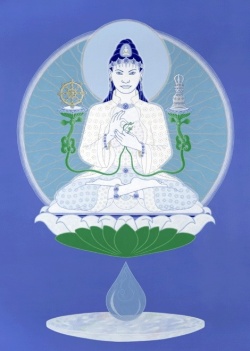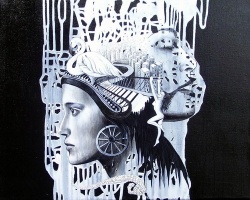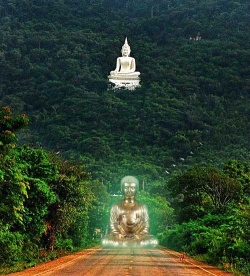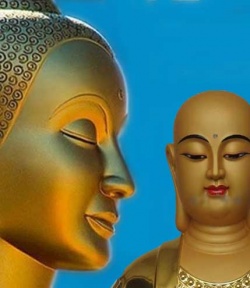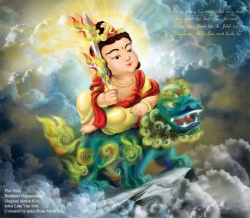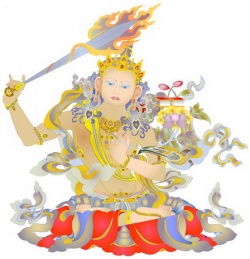Yangzab Dzogchen
When you listen or contemplate a teaching you need bodhicitta, the mind that wishes to benefit all beings. Once we have liberation, we can enjoy happiness.
This liberation is brought only by bodhicitta. If you are a prisoner or enduring hardships, it may seem that you have lost your freedom.
But if such things happen, you have not lost your freedom, because that is not ultimate freedom. The real loss of freedom is falling under the control of negative emotions.
For example, if we try to meditate, all kinds of negative emotions can arise, which take away our ability to dwell in mental peace. If we try to do the generation practice of the deity, it's hard to have clarity of visualization because of negative thoughts.
If we try to do prostrations or other positive actions we tend to procrastinate because of the power of our negative emotions. We lose our freedoms due to our negative emotions.
If we were in a prison but our minds were stable, we would still have freedom and happiness. If we can generate loving kindness and compassion, it stops these negative emotions. These mental qualities you can't buy, but they are present within our mental continuum.
The qualities of love and compassion can be powerful. We all are concerned with our own well being, but are willing to sacrifice it for our child.
The mind of love and compassion can be brought to this pitch. If you can give this love and compassion to your spouse and child, you can do the same for others. If you examine there is no difference between the two, all beings have the same wish for happiness.
If you need to tame a person, the real taming comes from loving kindness. An authority can handcuff a prisoner and torture them, but they cannot tame their mind this way.
It will only create more anger to the authority, like adding wood to a fire. One can create friendships only through the practice of compassion. If you try to help others, even those who have tried to harm you in the past will be tamed.
When we practice dharma, we can make prostrations and offerings, but the most effective practice is bodhicitta. It may be able to tame the mind through other practices, but the real taming comes through bodhicitta.
If you have a strong mind of bodhicitta, even mundane activities bring a lot of merit.
Bodhicitta can only bring freedom and this freedom automatically brings joy and happiness. Those people with bodhicitta are free because whether they meet friends or enemies they have the same happiness and have no worries. Once you possess bodhicitta it is similar to a wish fulfilling jewel.
When Miarepa's sister found him in retreat she said there are no other beings poorer than they. He replied there was no person happier than himself, because he had total freedom and control of his mind.
He also replied that he was wealthy and a warrior. It's difficult to practice like Milarepa, but we should practice bodhicitta as much as we can. If you cannot, at least be mindful of these practices.
The cultivation of bodhicitta benefits oneself, because it is the ultimate source of happiness and is the only thing that can bring us lasting happiness and enlightenment. As this Yangzab practice is so profound and can bring us enlightenment quickly, if you have any questions of bodhicitta, ask them now.
Q: Could you explain the bodhisattva warrior?
A: A warrior is someone who can protect themselves from harm. In an ordinary sense a warrior destroys his opponents that might harm him. If you have an enemy who wishes to harm you and instead of taking revenge you remain calm and generate compassion, then your enemy will be calmed. That is the activity of a warrior.
Q: Why did Milarepa say he was rich when he was poor and in rags?
A: What's your definition of wealth?
Q: Someone who can afford anything.
A: Maybe that's not the case. That may be correct in the ordinary sense. Can you say you are rich if you can gain all your satisfactions?
Q: Yes.
A: Milarepa was rich because he was fully satisfied. If you have millions of dollars, you can use your money in this life, but cannot take it with you in the next. Milarepa could take his merit. Does that make sense?
Now you have become enlightened, but may fall back because of your attachments. There is a story of a group of traders who travelled in a realm of ogres.
They thought that they were in heaven because of the beautiful women, but people they met told them it was really a realm of ogres.
They were told they could pass through safely, but if they remained they would become ogres too. The women they had met wailed and begged them to stay. Many remained and only a few left. So now you can have tea.
Within the Yangzab there are advanced practices such as Shitro, Tregchod, and Togyal. Nowadays it is known as Yangzab Dzogchen, but on the title of the text it is not called Dzogchen.
Normally you would start by teaching the preliminaries, but that's not possible in the time we have. I have received the transmissions and commentaries, but have not been able to do the retreats themselves. But they cannot be different than the fivefold mahamudra, even though there may be differences in expression.
In the future other teachers will come and if we request, they will teach on Yangzab at greater length.
So we will go though the text. It begins with an homage to Guru Padmasambhava and others. It says if you don't know the lineage of the teachings, it will be difficult to accept them. Padmasambhava is an emanation of Vajradhara, a representation of the dharmakaya.
He emanates from the sambhogakaya, which manifests as the hundred peaceful and wrathful deities.
He was born in Danakosha Lake during the reign of king Indrabudhi. The king did not have an child, so he adopted Padmasambhava as his heir.
Since Padmasambhava was an emanation, he could benefit beings through miracles, but in order to teach people by his example, he left to practice in a charnel ground. Dakinis told him to go to another cave where Garab Dorje was practicing.
So the Yangzab teachings came from Garab Dorje to Padmasambhava, and then to various teachers. Padmasambhava went to Bodhgaya to practice these teachings.
To meet his disciple Mandarava, he went to Zahor. She was the daughter of the king of Zahor. She was learned and many kings, such as King Gesar, asked her to become their bride.
Her father the king could not decide between them, because he would offend the other kings who did not get to marry her.
The queen advised the king to let their daughter leave and travel where she wished, so that the other kings would not be offended. Mandarava thought because of the merit from her previous lives she was born as a princess.
She thought if she remained as an ordinary person, that merit would be wasted.
Because she thought the kings were attracted solely by her beauty, she scattered her ornaments and her fine clothes and became a renunciate.
The kings asked her if she was sure she wanted to do this. She said yes. The king and his ministers said she could not go into retreat by herself and sent her off with five hundred servants. She met Padmasambhava who gave her teachings.
The rumor spread that she was having an affair with him. The king heard this rumor and became angry and declared he would give his treasure to anyone who could prove it. An ugly cattle herder came to the king and told the king that he had witnessed the affair.
The king sent his ministers to arrest Padmasambhava, but when they went to his cave, they could not arrest him because of the glory of his presence.
They returned and told the king that Padmasambhava seemed to be a god and not a human being. This made the king even more upset. He seized Mandarava and threw her in jail and then built a pyre for Padmasambhava and set it ablaze. The fire continued burning for two weeks and the king was puzzled and sent his ministers to check.
They found that in the middle of the fire was a lake and in the lake was a lotus where Padmasambhava was sitting with a hundred dakinis.
The ministers reported this to the king. The king came to the site and couldn't believe what he saw. He circled the pyre and looked from all directions.
He was convinced what he saw was real and prostrated and made supplications and offerings to Padmasambhava.
The king offered his robes to Padmasambhava, which is how Padmasambhava is sometimes depicted, in the robes of the king of Zahor. The king pulled Mandarava in a chariot and offered Mandarava and his entire kingdom to Padmasambhava.
Some historians believe Padmasambhava was related to the people who built Bodhinath stupa. The four sons who built it were born from one mother through different fathers.
When they asked what their fathers' work was, she replied they shouldn't do ordinary work, because her plan was to build the stupa. Her mother begged for a piece of land from the king that could be covered by a hide from cow's head.
The king gave her the land and she took the hide and converted it to a rope which she used to circle the land.
The stupa's Tibetan name is translated as "allowed because I let it slip from my mouth." After completing the stupa one son made the wish to be reborn as a powerful master and was reborn as Padmasambhava. Another son made a prayer to be born as a powerful religious king.
He was reborn as the Tibetan king, Trisong Detsen. A third son made the wish to to be reborn as a learned monk and was reborn as Shantarakshita.
One of the sons prayed to be reborn as a loyal servant to the other three and was reborn as Ba Salnang, a minister to the Tibetan king. It is said if you go to Bodhinath and make a prayer, the prayer will be answered.
It is said in Achi's life story that when her parents had difficulty conceiving they want to Bodhinath and made a prayer and later she was conceived.
When King Trisong Detsen was building Samye monastery he had difficulties because what he built was destroyed at night by evil spirits. After inviting Shantarakshita many things were calmed, but some evil spirits still created obstacles.
So Guru Padmasambhava was invited by Ba Salnang.
When he was travelling to Nepal, Padmasambhava was already travelling to Tibet. When they met, he told Yarlung he could return and Padmsambhava would come in time.
Many of the evil spirits were tamed by Padmasambhava. After his arival Samye monastery was completed. Padmasambhava did a mountain retreat for four years.
After the retreat Padmasambhava gave an empowerment and told Trisong Detsen if he attended he would have a really long life.
The king was unable to attend and because of his previous karma died at a young age.
Guru Padmasambhava gave many teachings of interpretative meaning at Samye to King Trisong Detsen's son, his ministers, and other students.. After that the disciples requested the teachings of the definitive meaning.
So Padmasambhava gave the teachings of the Yangzab. When he had finished, he said that he had given all the teachings of the peaceful and wrathful deities, but said that the king would not be able to accomplish all these teachings. He prophesied the king would be reborn and practice the teachings then.
So Padmasambhava hid them as a terma teaching. They were written on six types of papers: gold, silver, turquoise, conch shell, iron, and bronze and hidden on a rocky mountain.
Rinchen Phunstok was born in the time of the 16th Chetsang and was the reincarnation of Trisong Detsen's son. After discovering the terma, he practiced it, achieved it, and then taught it to others.
Mastering a terma teaching before spreading it increases the power of the terma. Karma Lingpa was one of the eight tertons.
He gave the termas he had discovered to a single disciple and told him to do likewise for three generations. Then it was taught widely.
After Rinchen Phuntsok practiced the teaching, he got empowerments through visions from Padmasambhava. The names of the lineage holders are mentioned in the text, but we needn't discuss them today.
If you ask what needs to be practiced, we cannot jump directly into the main practice of the text. We might find it difficult to hold onto the various teachings, and they might be confusing.
An old woman asked a lama for teaching and he told her to do positive actions and avoid negative actions.
After hearing his teaching she said when I listen to the teachings on the positive actions it seems that not only you, but all beings will attain benefits.
And when I listen to the teaching on negative actions, not only I, but you will have the negative results. So it is important to start with the four thoughts and the five preliminary practices.
When you engage in Mahamudra or Dzogchen, the profundity of the practice depends upon the student. If you run after teachings thinking this is most profound.
It's like a farmer who started growing potatoes and then dug them up to grow corn when someone told him it took less time, he kept doing this until he had no harvest at all.
There are 84,000 teachings and its important to hold one as your practice. But you can listen to other teachings. I'm not saying one teaching is more profound. It wouldn't benefit if you tried to do all the profound teachings.
The text begins with practicing the four thoughts which turn the mind to the dharma.
The four turnings of the mind are more profound than Dzogchen and Mahamudra. Without practicing the four turnings you cannot engage in Dzogchen and Mahamudra.
If you have a good foundation in the four turnings you automatically are a good practitioner.
You are naturally inclined to spiritual practices. Without a good foundation in these practices you may have a desire to practice when things go well, but when you face difficulties the desire is not stable.
There's a Tibetan saying that when you have good times you wish to do spiritual practices but when you face difficulties, you blame the practice and stop doing them. The four thoughts start with contemplating the eight leisures and ten endowments of a precious human birth.
I have taught these many times so I won't talk about them in detail. But you should know them by heart.
In Arizona I did this teaching and we did a meditation on them. Afterwards some told me they had done a practice similar to shamatha, which is an incorrect way to practice this contemplation.
If you don't memorize the teaching and the teaching is only in books, then it will be of no benefit to you. At one time a student didn't take the teaching on impermanence seriously.
So his teacher told him that he had something important to teach him. His teacher gave him a needle and told him if he kept it safe the needle would protect him after death.
He thought about how he would be able to take it with him after death. He went back to his teacher and asked how he could take the needle with him after death.
This caused his mind to change and he kept the teaching seriously after that. If the teaching is in your mind it cannot be taken away by thieves and authorities. You can even take it with you after death.
We should be aware that the leisures and endowments are difficult to obtain and requires a great deal of merit from your previous lives. It is similar to a wish fulfilling jewel.
You can use this life to achieve anything. You should also recognize the impermanent nature of this life. If you don't recognize this, you will be unable to use this fully.
We all have the desire to experience happiness and avoid suffering, so we should know what is the cause of both.
And you should know the faults of all the realms of samsara.
We may dedicate our merits to fortunate rebirth, so this should be avoided. So this is a brief discussion of the four turnings of the mind. If you have any questions please ask them.
Q: Do the stories you told us also have a symbolic meaning?
A: The stupa at Bodhinath is a symbol of Buddha's mind, so if you make prayers to it, it serves as a field of merit. Regarding the lake, it is a pilgrimage site, where beings can receive blessings.
A person can bless a site When Padmasambhava came to Zahor and taught the kings and his subjects, the whole valley became enlightened and the people vanished, because the valley had been blessed by Padmasambhava.
Milarepa said he blessed Lapchi and said if someone practiced there for one week it was worth several weeks at an ordinary place. This shows the place had been blessed by him. Likewise a holy site can bless a practitioner so that their practice becomes more fruitful.
Q: What is the method for meditating on the four thoughts and how do you know you have achieved the fruit of the practice?
A: You cannot practice them as shamatha.
You should think about them by considering each of the endowments and leisures and think how difficult they are to achieve by considering how uncommon they are.
That is how you can practice them. By going through all these points one comes to a point that one is fully convinced that they are difficult to attain and therefore this life is precious and one should not waste it. One you have this attitude you can say you have the result of the practice.
Q: How do sacred places hold their power?
A: When Milarepa meditated at a place some kind of energy was imprinted there. If a true bodhisattva lives a valley all sentient beings in the valley are connected to the practitioner through the movement of the wind and water and none will be reborn in a lower rebirth.
I did a pilgrimage for a year visiting the holy places of Padmasambhava and other masters. If you go there, you will have a special feeling of comfort and joy.
Your spiritual practice will be more effective and your mind will be clearer. All this is because of the blessings of the spiritual masters.
If someone has true bodhicitta, the local spirits are aware of this and are pacified and help rather than harm other beings in the area. Even if you don't practice in these places you will feel something different.
Q: How do you reconcile the teachings on past lives with the injunction to have present moment awareness?
A: What do you mean by remaining in the present moment?
Q: To not worry about the future or regret the past, but to remain in the present.
A: We can never find the present. We should be clear about this. We should know past history. And it is important to not have conceptual thought. But these are two different things. Without learning about past teachers we cannot come to the nonconceptual state of mind. If you say you should just not think about anything, you will not achieve anything except more tension. This will be explained later.
Q: Isn't remaining in the present moment mindfulness?
A: Mindfulness is if someone harms you for no reason you will not think of retaliating. Mindfulness is remembering the faults of anger.
Q: What does Dzogchen mean?
A: Dzogchen is like having food and tea. If you eat the food and drink the tea, that is Dzogchen.
It's typically the practice to be humble and say you don't understand the teaching.
The translator told me that some students in Europe received a teacher. He was humble and said that he didn't know anything.
The students were upset and called India and asked why they didn't send a better teacher. So I will say a few words on Dzogchen, even though I don't know anything.
To accomplish the two factors of the path you need to train in the accumulation of merit and wisdom. To achieve Dzogchen and Mahamudra it's indispensable to have the preliminary practices. To practice Mahamudra traditionally you must practice shamatha and the Six Yogas of Naropa.
I won't talk about these things, but say a few words about mahamudra. The 84,000 teachings were taught for the sake of taming the mind.
If the 84,000 faults are condensed, they are the five poisons. These emotions obscure the true nature of reality.
We need to know the empty nature of these afflictions. When you meditate on Mahamudra you should establish that these emotions lack true existence.
By establishing this, one meditates on mahamudra. In the Mahamudra there are teachings that say that negative actions don't cause suffering and good actions don't bring happiness. We need to eliminate the grasping toward wholesome and unwholesome actions by seeing them as empty.
So how do we realize emptiness? When attachment and aversion arise, we need to see they have no real existence and are empty. If I see a cup is empty, I won't try to drink from it. If I see aversion and attachment are empty, I won't run after them.
Q: Isn't the view empty as well?
A: We need to establish that phenomena are empty of true existence. This can be done by analytical meditation, concentration, or other means. But this understanding does not possess the mirror like quality of the five wisdoms.
But realizing the emptiness of them does not mean you refrain from positive actions.
The five Buddha families are within oneself. The corresponding practice in Tantra is to take up the negative emotions that are usually avoided.
For a practitioner the negative emotions are beneficial, like spreading manure around a tree. The practitioner first attains a state of equanimity.
When a negative emotion arises the practitioner sees its empty nature and this transforms it into the mirrorlike wisdom. So you shouldn't pursue of the negative emotions, they will arise on their own.
The practitioner sees samsara and nirvana like the two sides of the hand. So this is the teaching on Dzogchen.
Q: So are we supposed to only view negative emotions as empty?
A: You need to eliminate grasping to both positive and negative emotions. If you feel pride in a wholesome action, this pride should be seen.
Q: Isn't it true at the Dzogchen or Mahamudra level you just let emotions go?
A: In the practice of Mahamudra and Dzogchen we talk about the five wisdoms. There is no wisdom other than these in the Mahamudra.
Q: Isn't it correct that we're just recognizing the wisdom?
A: It's not transforming emotions into wisdoms. There are no emotions different from the wisdoms and no wisdoms other than the emotions. But we need to experience then through practice. It's almost impossible to explain this through words. You need to experience this through meditation. If you experience this through meditation there cannot be many questions.
Q: Once you have a firm foundation in the preliminaries doesn't dealing with negative emotions become second nature?
A: It's not just the preliminaries, there are other practices that haven't been described. True compassion only arises after the realization of Mahamudra. By realizing Mahamudra you see it is crucial that other beings to realize this and this generates the highest compassion for sentient beings.
Q: Could Rinpoche talk a little about Ground Mahamudra and Original Mind?
A: Do you mean the primordial mind, buddha nature?
Q: Yes.
A: The essence of mind is present in all sentient beings so there is no difference between an ordinary person and the realized practitioner. This mind is not created newly. It like the moon that is there whether it is cloudy or not. Whether you see the reflection depends on whether it is cloudy or not.
Q: Is it true that the Mahamudra and Dzogchen teachings are intended for advanced practitioners and don't make much sense until you have completed the practices that lead to them?
A: That's true. You have to do the preliminary practices first. But if you give the teaching it plants the imprints for the future. And there are some persons who due to their practice in previous lives can understand.
Q: How are we supposed to develop the awareness of emptiness to do this practice?
A: It's true, it's difficult to see the empty nature of the emotions. If you train in the empty nature of thoughts the awareness will get stronger. The ignorance that sees emotions as truly existent is false. If you follow the path you will get to the point of realization.
